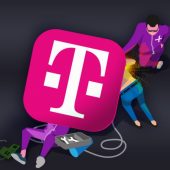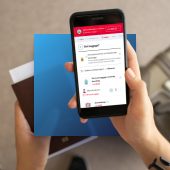Dragged by legacy and an already high bar for CX, incumbent operators have a hard time improving their NPS. Here is how they can follow in digital natives’ footsteps by creating a smooth and easy self-care solution with the help of APIs.
Customers expect to manage their accounts easily and without much fuss, while either watching their favourite TV show at home or being out and about on a long-awaited holiday in Italy. Operators simply can’t not offer the option of a self-care application to digital natives – who are, well, basically everyone born after 1996. As it reduces operational costs (mostly of customer centers), this platform is just as advantageous for telcos, who often use it as one of their main marketing channels as well.
A win-win situation, one might say. But what do customers really expect from these apps? Is it the large variety of features or personalized promotions that, in the end, lead to a top-notch customer experience (CX) – and thus, a better Net Promoter Score (NPS) for telcos?
Truth is, most of the time people do not need magic, just a self-care app that they can – despite how unnatural it sounds – use as little as possible.
Yes, you heard it right.
Digital native companies setting a new standard for CX
Apple, Airbnb, Uber, Netflix and other digital native brands have set a new bar by delivering a customized, easy and frictionless experience. Since this has evolved from a nice-to-have to a must-have, the excellence of CX is now measured against those of other kinds of competitors.
As the telecommunications industry’s global association, TM Forum states in its report on digital maturity, “technology and customer experience are two sides of the same coin for digital natives.” With its average NPS typically being in the 20s (versus more than 50 for many digital powerhouses), the telecom sector is among the less popular ones.
It is in telcos’ best interest to embrace a top-notch user experience and keep up with their customers’ digital expectations, which are simplicity, high performance and a seamless overall experience.
Easy, right? Well, not so much for incumbent telcos.
Not born (but) to be digital
Through digital transformation, operators can achieve a significant increase in the key customer-satisfaction metric. TM Forum’s Digital Maturity Model (DMM) was designed to back Communications Service Providers (CSPs) up by giving a snapshot of where in the transformation journey they are at the moment. But even if they see it as an investment rather than a cost, non-digital natives are most likely to face several obstacles on the road to becoming digital. Which often results in aiming to solve the urgent challenges instead of the important ones – and thus at much greater expense.
One of the main bottlenecks, surely, is legacy.
Due to historical reasons, incumbent telcos usually sit on a surprising number of legacy systems. It has been addressed many times and is an ongoing dilemma for the entire sector. Enormous projects were grounded during the digital transformation of many companies to consolidate and modernize the Operation and Business Support Systems (OSS/BSS) – often spanning years in time and millions of Euros in value.
To meet customers’ rapidly changing demands, some operators have started to create their separate “digital-attacker” sub-brands: a sorely simplified and differentiated product, built independently from the legacy business. However, while this strategy certainly has its advantages, the digital transformation of the core business remains a challenge.
Concealing a weighty legacy
The rise of decoupling and APIs shed light on a solution. The separation of legacy B/OSS systems from customer-facing frontends is a key factor in solving performance issues while reaching the desired level of speed, control and most importantly, user experience.
Let’s just have a quick peek at some of the benefits:
Decoupling enables telcos to use cutting edge frontend technologies while integrating the legacy backend services via APIs.
Concealing the complexity and fragmentation of backends allow frontend developers to adopt best-in-class technology and, later on, switch to even newer ones. The UX/UI team can easily make changes to the design suiting customers’ needs or implementing new features, without venturing into backend territory. All of this leading to a maintainable solution, with calculable maintenance costs in the long run.
Such integrational APIs are becoming standard in the industry, like TM Forum’s Open APIs specification, which we personally are well familiar with.
It eases tension via business and IT.
Decoupled architecture allows business to have control over the customer facing interfaces by floating those away from the core IT domain. IT and security teams are willing to allow e-commerce and marketing teams to take control over frontends, providing it does not have an affect on business critical backend systems.
Well-documented and standardized APIs are much easier to use for internal and external teams as well. Front- and backend developers can work without dependencies and in parallel, thus reducing overhead costs while accelerating TTM.
Frontend separation enables business to reach the optimal TTM.
Well-documented and standardized APIs are much easier to use for internal and external teams as well. Front- and backend developers can work without dependencies and in parallel, thus reducing overhead costs while accelerating TTM.
The renowned advisory firm McKinsey & Company presented a similar reasoning on the topic:
Forward-thinking telcos that are already undertaking the process aim for a target architecture comprising three layers: a front end delivering a best-in-class, mobile-first customer experience; an agility layer based on a microservice platform to enable flexible and scalable development of services that move business logic away from legacy back-end applications; and a back end with a module-based product catalog that allows easy and quick extension of the standard telco product stack to accommodate new business units or partners.
– McKinsey & Company report, January 2019
An easy self-care solution for customers and telcos alike
If telcos commit themselves to pursue a supreme CX, real impact is possible regardless of the piled up legacy. By overcoming technical burdens, there is no more crucial obstacle between them and a maintainable app or portal that serves their customers best.
As a digital vendor with a decade of domain experience, at Mito Digital we love to design and build self-care applications just like that – making it a frictionless experience for both operators and their customers.
Living and breathing telecommunications, we have delivered a great many digital interfaces for Vodafone Hungary as well as for the Deutsche Telekom Group. Among them, DT’s centralized self-service mobile platform known as the One App.
One (self-care) App – five countries
Deutsche Telekom’s initiative to unify their self-care application on the fragmented footprint of Europe was a bold move. Today it is recognized as an industry best practice – launched in five and now used in nine countries across the continent. The One App, which Mito Digital designed and delivered from scratch, became one of DT’s flagship projects back in 2018.
Our UX/UI team defined the visual language of the app that later has become a lightweight, yet flexible implementation with a strong focus on maintainability and extensibility. Its new integration layer – called Harmonized API Layer (HAL) – was designed centrally by DT using TM Forum Open APIs, which enabled the development of a single mobile client for many countries. In addition, we needed to build a lightweight adaptor and mediator middleware layer – called Backend For Frontend (BFF) – aimed to be optimized for mobile app use cases.
If interested in the hows and whys, you can check our case study on our website.
While personalization and engagement are nice, first things first: what telcos (and their customers) need above all is a simple, yet highly performant app with a seamless experience. Self-care apps that customers spend less time using are the ones they are more likely to use willingly – leading not only to a greater CX for them but also to a higher NPS for telcos. A win-win situation, as anyone would say.
Mito Digital is a business unit of Mito, a unique powerhouse of creative & digital experts with a passion for clever things. We have been working with our clients around the globe for more than ten years, in numerous industries from aviation through lottery and retail to telecommunications. Our goal is to design and deliver smart, human-centered and best-in-class digital solutions that meet and exceed the business goals of our clients as well as the demands of their clients. Our expertise in the telco industry covers applications and portals both in the B2C and in the B2B segment, responsible for self-service and sales functionalities.
The author(s)
Csaba Végső
Director of Business Development
Csaba has been with Mito Digital since 2012, currently working as the Director of Business Development. He has a deep technical background gained from managing enterprise-level web and mobile projects, especially for telco clients. Today he is diligently focused on establishing Mito Digital's international recognition in various industry verticals.


